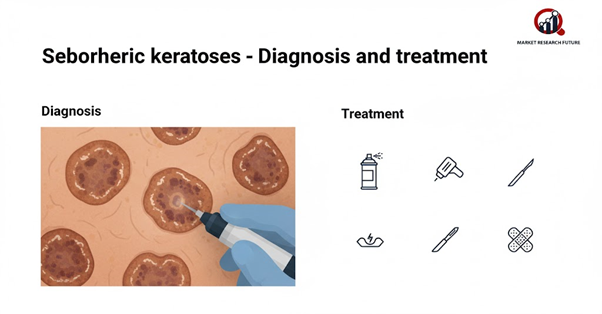Seborrheic keratoses: Diagnosis and treatment

Overview of the Seborrheic Keratoses Market
Changing consumer preferences, especially the rising inclination toward purely aesthetic appeal, are changing the landscape of seborrheic keratosis. Upsurge in these treatments will help the sector reach USD 4.56 billion by 2035, rising from USD 2.45 billion in 2024, owing to a moderate pace of progress, adhering to a CAGR of 5.8% through 2035.
A seborrheic keratosis, also known as a seborrheic wart or corn spot, is a benign skin tumor that commonly appears on the trunk and other areas of adults. It is non-cancerous and poses no health risks, although it may become itchy or painful if left untreated.
Seborrheic keratosis is a widespread dermatological condition affecting both children and adults, though it is more prevalent among older individuals. Studies suggest that nearly 40% of people over the age of 50 develop these lesions.
They typically appear as brown or black wart-like bumps that may resemble cracked earth and are commonly found on sun-exposed areas such as the face, chest, ears, hands, and arms.
While seborrheic keratoses are benign, they can sometimes be mistaken for actinic keratosis, basal cell carcinoma, or squamous cell carcinoma. For accurate diagnosis, a biopsy may be performed when symptoms appear atypical.
In most cases, however, treatment is unnecessary unless the lesion becomes irritated, infected, or cosmetically concerning. The exact cause of seborrheic keratoses remains unknown. However, genetic factors play a key role, particularly mutations in the TERT and PAX3 genes found on chromosome 16p12.
Individuals with a family history of the condition have a higher likelihood of developing it. Despite this, seborrheic keratoses are not contagious and do not spread through physical contact.
Although the condition is generally harmless, patients may experience itching, redness, or mild inflammation. Maintaining proper skin hygiene, avoiding excessive sun exposure, and seeking dermatological advice for any changes in size, color, or texture are important preventive measures.
Regional Analysis
Globally, the prevalence of seborrheic keratoses increases with age and sun exposure. In North America and Europe, cases are particularly common among older adults with fair skin, largely due to UV exposure and lifestyle patterns.
Asia-Pacific countries, including Japan, China, and India, report growing numbers of diagnoses as awareness of dermatological health improves and urban populations face higher pollution and sun exposure levels.
In Australia and New Zealand, where UV intensity is high, seborrheic keratoses are among the most frequently reported benign skin lesions. Meanwhile, Middle Eastern and African regions show fewer documented cases, possibly due to underreporting and darker skin tones offering greater natural protection.
Overall, dermatological clinics worldwide are emphasizing early diagnosis, genetic testing, and safe removal techniques to manage and differentiate seborrheic keratoses from malignant growths.

Leave a Comment